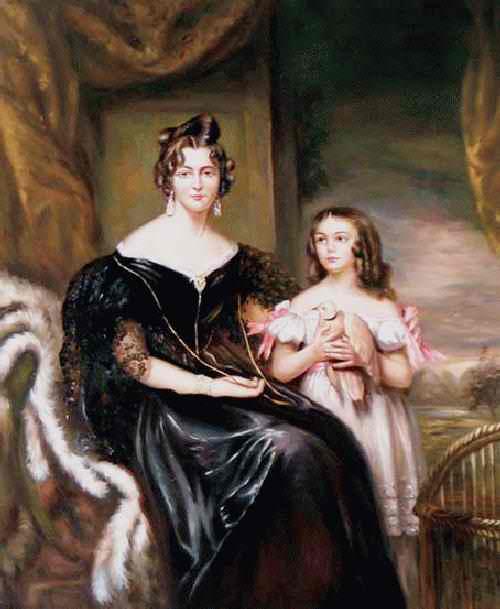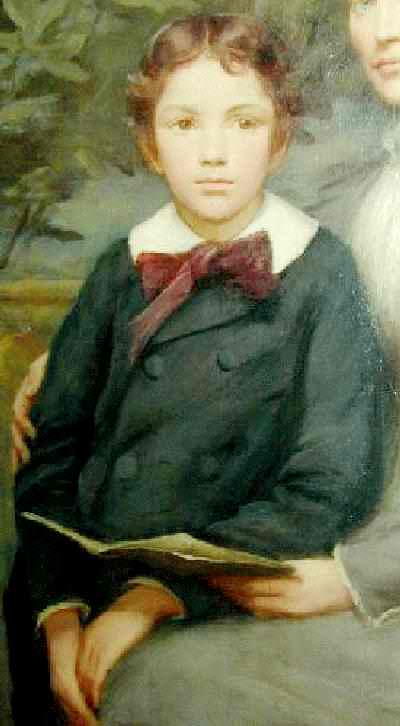
Unidentified Paintings Artists Illustrating Boys' Fashions

Figure 1.--We do not know who the artist is here. We might guess the painting is English, perhaps fating to the 1830s, but we have no real idea. Surely the child is a girl. What interests us here is the use of pink ribbons on the leading strings. Did the color have gender connotations. Also notice the ringlet curls. We are insure to what extent boys and girls wore them in the early 19th century. Identifying this image will add some insights to these issues.
|
Some HBC contributors have sent several fascinating art works, but have not provided any background information on these works or even who the artist was. Without knowing the artist, it is difficult to use the image in our assesmment of historical or national trends so we can better undestand fashion trends in the years bdefore the development of photography. We would be very interested in any help HBC readers could offer in identifying and dating these artistic works. Here reader comments are welcome. Either help in identifying these works or insights on the fashions illustrated.
Figure 1 (1830s?)
We do not know who the artist is here (figure 1). We might guess the painting is English, perhaps dating to the 1830s or 40s, but we have no real idea. Surely the child is a girl. What interests us here is the use of pink ribbons on the leading strings. Did the color have gender connotations. Also notice the ringlet curls. We are insure to what extent boys and girls wore them in the early 19th century. Identifying this image will add some insights to these issues.
We are not positive, but this painting looks American or English to us. We would date it to the late 19th century, perhaps the 1880s. It pictures a tender momenmt between a mother and child. The lady wears a luxurious orange dress and is olaying with her baby in front of a musical instrument, perhaps a harpicord. The baby wears a long white baby dress.
This domestic genre image looks to have been painted in the mid-19th century, perhaps the 1870s. It looks British, perhaps American. There are three children playing inside a modest home. One is clearly a boy and another a girl--note the red hair bow. We are not sure about the younger child wearing the pinafore. This child could either be a boy or girl. The short hair suggests it nay be a boy. The kitten suggests it may be a girl.
Here we believe that we know when and wear this charming portrait was painted. The little boy's sailor tunic suggest that the paortait is American, painted about 1895. This may be another painting that is difficult to attribute because it was probably not dione by a major artist. It does illustrate popular conventions at the turn of the century. We are not sure, for example, to what extent girls wore tunic suits like their brothers. In this family at least, a tunic suit waa a boy's outfit. This little boy older sister wears a plain white frock. Many girls at the time had long hair and hair bows. Some girls, however, like this girl had short hair. Notice that the boy's tunic suit is brown.

Figure 5.--Here we should be able to identify the portrait as it looks to be from a major artist although it is is just part of the portrait of a mother and child (figure 5). It looks to me to be English, probably painted in the mid-19th century. The boy wears a double breasted suit with a wide collar, probably an Eton collar.
|
Figure 5 (1840s?)
Here we should be able to identify the portrait as it looks to be from a major artist although it is is just part of the portrait of a mother and child (figure 5). It looks to me to be English, probably painted in the mid-19th century. The boy wears a double breasted suit with a wide collar, probably an Eton collar. It is difficult to tell for sure, however, because of the maroon floppy bow. The boy has realtively short hair although down to his ears. It is parted in the middle.
We do not know who was the painter, but he os obviously a competent artist. This lovely country scene looks to be a mother and her seven children who look like they are at a picnic. We would guess that this is English. It looks like it was painted in the 1840s. Some of the children are obviouslys boys or girls. We are noy sure about the youngest child in a blue dress. The two children on the ground to the left of the child that is standing look to be boys. One boy wears a black probably velvet jackt with a lace collar and grey pants. The other boy wears a red dress.
This American primitive may have been done in the 1830s, although that is just a guess. I doubt if it was done much later in the 19th century. We do not know who the artist was. The boy has short hair wears a front buttoning black tunic with plain white panatalettes. The gender in many of these priutive paintings is difficult to determine, but this boy is definitely a boy. The dog is further confirmation.
We would guess that this painting is a an American work. We assume that the image repesents an immigrant moving west to find a homestead to farm. Here we are somewhat confused in that the father is not facing a wildreness, but an already settled area. Perhaps the man is a new immigrant greeting a family member that came before him. Interestingly his some wears what looks like a belted smock over a tunic ad long pants. I ahave never before seen a pioneer boy portrayed in this manner. It looks like the family has been deposited here by the cart at right.
We would guess that this is another American work, note the eagle on the mirror. Thisis a wonderful of the inside of a clearly prosperous middle-class home. The children are playing doctor. We are not at all sure about the date. We might guess that it was taken in the 1850s. The patient is a girl. The doctor looks to be a boy wearing a tunic outfit. The boy in the center wears a yellow jacket or tunic, it is a bit difficult to tell. The child on the chair looks to be a boy wearing a dress. I'm not sure if the child by him is a boy or girl.
Here we have a fascinating scene from a one room rural school. There are two school mistrisses. We would guess that this painting is British, perhaps Welsh. I am not sure about the date, but would guess about the 1860s. Many of the children were wearing tams, both boys and girls. A lot of the children also wear pinafores. The reason we think that this might be Welsh is that the fancy white bonnet that one of the girls wears. The boys seem to be mostly wearing kneepants. We are not positive if the child by the window wearing a pinafore is a boy or girl. The boy at the left wears kneepants. We are not sure why he is so unhappy.
We have no idea who this artist was or where he painted. We suspect it is English, but we are not sure. The painting is undated, we might guess that it was done about 1840. Nor do we know if the child is a boy or girl. The child appears to be wearing a dress and pinafore with long hair. Note the child's toys in the table. There looks to be a doll riding a lion and some other toys that are difficult to identify.
We also have no information on this street scene. It looks rather like it may have been painted in the 1890s. The painting shows children skipping rope in front of a backery. The street looks like it could be anyhere in Europe. The fearures of the mother and children look Italian. Each of the three children wear pinafores and dresses of various design. Interestinglybone is yellow and not white. The children may all be girls, but the child on the right with short black hair may be a boy. Children of that age still commonly wore dresses in the 1890s. Of course the child may be a girl with short hair.
HBC

Navigate the Boys' Historical Clothing Web Site:
[Return to the Main unknown artist page]
[Introduction]
[Activities]
[Art]
[Biographies]
[Chronology]
[Clothing styles]
[Countries]
[Girls]
[Bibliographies]
[Contributions]
[FAQs]
[Glossaries]
[Satellite sites]
[Tools]
[Boys' Clothing Home]
Created: March 12, 2003
Last updated: March 21, 2003




